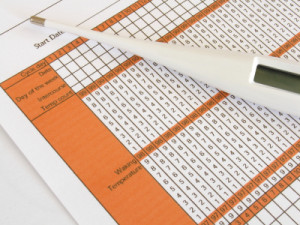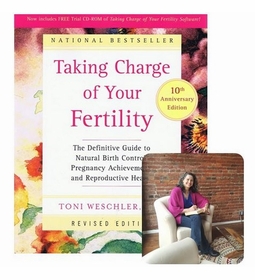All About Ovulation
How Do I Know When I Ovulate?
Knowing when you are most fertile is one of the most important steps in trying to conceive. Contrary to popular belief, you  can only get pregnant during a short time of your menstrual cycle. This fertile time occurs a few days around ovulation when an egg is released from your ovary. If this egg is fertilized by sperm and implants successfully in the lining of the uterus, pregnancy begins.
can only get pregnant during a short time of your menstrual cycle. This fertile time occurs a few days around ovulation when an egg is released from your ovary. If this egg is fertilized by sperm and implants successfully in the lining of the uterus, pregnancy begins.
The book Taking Charge of Your Fertility by Toni Weschler provided the main resource for this article and is THE book on charting your cycle to either help you avoid pregnancy or enhance fertility and just recently celebrated its 20th anniversary.

Taking Charge of your Fertility Book
Here’s a quick review of basic biology before we go on.
The Menstrual Cycle
One menstrual cycle is the time that elapses from the first day of one period (bleeding) until the first day of the next one. Day 1 of the cycle is the first day of real bleeding as in bright red bleeding.
The time from day 1 to ovulation is called the follicular phase or "first half" of your cycle. In textbooks, the average menstrual cycle is 28 days in length with ovulation occurring on Day 14. The second half or luteal phase is the time from ovulation to the start of your period. This is usually 14 days in length.
In most women, the first half of the cycle varies in length. It is usually the length of the first half of your cycle that determines the overall length of the menstrual cycle. For example, a woman who has a short follicular phase and ovulates on Day 12 will most likely get her period 14 days later making her whole cycle 26 days in length. (12 +14) If a woman ovulates on Day 20 of her cycle, she will have cycles that are a total of 34 days in length (20 +14).
How Do I Know When I Ovulate?
There are several methods to figure out if and when you are ovulating that range in reliability and accuracy.
If you have sex every day or every other day, you don’t really need a calculator. Unless there are issues with either the man or woman that affects fertility, you will get pregnant in time because with frequent sex, you won't miss the fertile window around ovulation.
However, there can be many reasons why couples are not having regular sex so then it becomes important to know about timing.
Word of advice: If you are not pregnant after a year of regular intercourse timed around ovulation, I suggest couples seek guidance from a fertility specialist. For those older than 35, it is advisable to seek help after around six months.
Calculating Ovulation
1. Counting Back 14 Days from the Start of Your Period
In a healthy woman with clockwork-like cycles that are 28 days in length starting from the first day of one period to the start of the next one, ovulation is probably taking place around day 14, i.e. 14 days before the next period is to begin. HOWEVER, most women’s cycles vary in length each month, so you could be ovulating much earlier or later than day 14. This means depending on when you are having sex, you can miss your fertile window.
2. Online Ovulation or Fertility Calendars
These are OK to use in the beginning when you are starting out trying to conceive (TTC) but they don’t take into account monthly variations in cycle length. They use the formula discussed above to calculate ovulation. Again, if your cycle is VERY regular then they can help but if your cycle varies each month then they are less helpful. If you have been using these kinds of calculators for more than two months or so and still aren’t pregnant, then it’s time to find a more accurate way to detect your fertile window.
3. Ovulation Predictor Kits (OPK)
These kits look very similar to pregnancy tests. Some are easier to use than others. An OPK tests the level of luteinizing hormone (LH) in your urine. Around 36 to 48 hours BEFORE ovulation occurs, a woman will experience a surge in LH. The ovulation predictor tests are designed to detect this surge. If you get a positive, then have intercourse every day for the next few days.
How do you know when to testing for your LH surge? If you have a regular cycle that is 28 days in length every time, start using the kits around day 11 of your cycle. On the other hand, if your cycle varies in length, I would advise to start testing around day 10 or earlier if your cycle is less than 28 days in length. In some women, the surge in LH can be short-lived so if you only test in the morning and not again that day, you could miss the surge and not see a positive on the test. Other problems with these ovulation predictor tests include insensitivity to lower than average surge levels of LH, inability to detect LH in urine that is too diluted and difficulty on the part of the user in interpreting the results. Women who have polycystic ovary syndrome (PCOS) tend to have continuously elevated levels of luteinizing hormone (LH), giving them false positives on the ovulation kits. Finally, these tests are very expensive and you need several tests per cycle. My advice to my clients is to combine ovulation prediction kits with the following two methods for good accuracy.
4. Charting Your Temperature
Measuring your temperature every day is a simple yet effective way to get to know your fertile window.
The basic idea behind charting is this: your body temperature is at one level before ovulation and rises after ovulation. After completing your temperature chart for one cycle, you should see a bi-phasic pattern, i.e. one temperature level before ovulation and a shift to a higher temperature level after ovulation.
Normal waking temperatures range on average from 36.1 to 36.6 Celsius (97 to 98 F) before ovulation and rises to 36.6 to 37.1 Celsius (98 to 99) degrees after ovulation. After ovulation temperatures will stay elevated until you get your period and then drop or will continue to remain elevated with pregnancy.
The temperature rise occurs AFTER ovulation due to the particular hormone levels at that time. The rise in temperature indicates that ovulation has already occurred. So why, you may ask, take my temperature when I won’t know when I ovulate until after it is has occurred?
The importance of taking your basal body temperature is to begin to see when you usually ovulate in your cycle, which will help in the following ways:
• After completing at least three charts, you will be sure that you are ovulating and will get a clear idea of when you usually ovulate. You can then check for other signs of ovulation several days before you expect to ovulate so you can time intercourse. (See below for a description for other signs of ovulation)
• You will be pretty clear about when you ovulate, which means you will know when to do an ovulation predictor test (OPK) to double-check ovulation. OPKs will show positive around 24 to 36 hours before you ovulate. If you have no idea when you ovulate, you may have to spend many days (and a lot of money on tests) to keep doing them until you get a positive sign.
• Taking your temperature also shows how long your luteal phase is and gives an indication if there is adequate progesterone to support implantation of the embryo. Your luteal phase should be between 12 to 16 days with 14 being the average. Your temperature should remain elevated for this amount of time and not dip down to pre-ovulatory temperatures.
How to Record Your Temperature on a Chart
Keep a digital thermometer, pen and chart by your bed.
I. Take your temperature first thing upon awakening, BEFORE ANY OTHER ACTIVITY such as getting up to use the bathroom or brushing your teeth.
II. Take it about the same time every day, within an hour or so.
III. Take your temperature after AT LEAST THREE CONSECUTIVE hours of sleep. So, for example, if you usually take your temperature at 7am but wake at 5 to go to the bathroom, it’s better to take your temperature then, otherwise you will have only had two hours of sleep before taking your temp.
IV. Record the temperature on a chart designed for this purpose. There are downloadable charts online at www.tcoyf.com
5. Observing Your Body’s Fertility Signs
The major sign that your body gives you that you are approaching ovulation is fertile cervical fluid.
Cervical fluid is produced in the days prior to ovulation (fertile window) in order to protect, nourish and generally make it easier for the sperm to swim up through the cervix into the uterus.
How do you check for this fertile cervical fluid?
Once your period has ended, start checking for this fluid when you use the bathroom. Use either clean fingers or tissue to wipe the vaginal opening. You are looking for fertile fluid that is wet, slippery and has the consistency of egg-whites. If you are using your fingers to check, it will stretch between them before breaking. Or you will feel that the toilet paper slips easily as you wipe. Look in your underwear, too. Egg white cervical fluid will look more like a round circle in your underwear as opposed to discharge that occurs at other times in your cycle that will appear as streaks.
When explaining to women what to look for, I ask them if they ever out and about and get that sudden feeling that their period has started early. Nearly all women laugh and respond, “Yes!” I tell them if they were to check the day of their cycle, they would most likely find that it is around the middle, near ovulation, and that what they are feeling is their fertile cervical mucus.
Once you are tracking the days of your cycle, you will become much more aware of this cervical fluid. I find that this is one of the most accurate indications of ovulation. I tell women that if they notice this fluid they should have sex regardless of what the ovulation predictor kit might be telling them.
Word of advice: There can be many reasons why a couple cannot get pregnant; reasons that cannot be detected without help from a doctor or fertility specialist. If you are not pregnant after a year of regular intercourse timed around ovulation, I suggest couples seek guidance from a fertility specialist. For those older than 35, it is highly advisable to seek help after six months.
